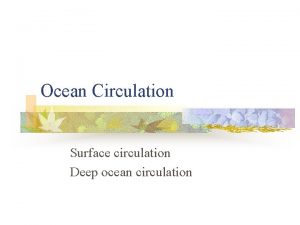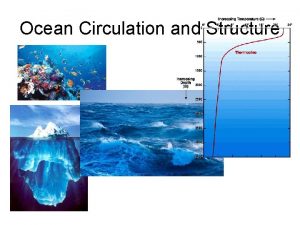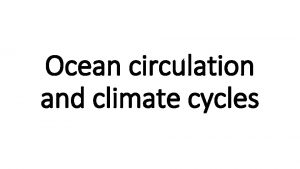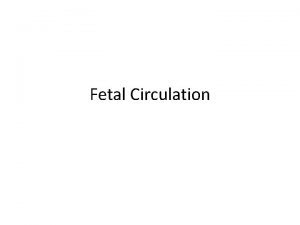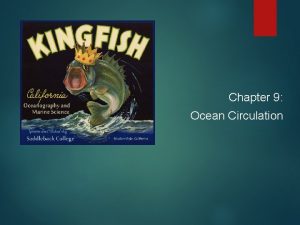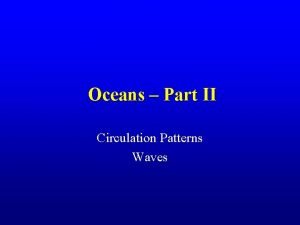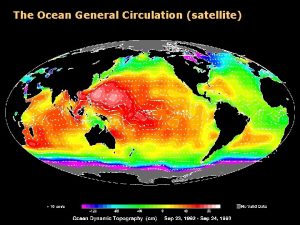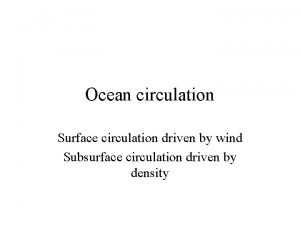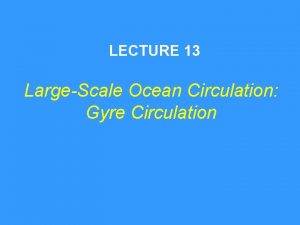CHAPTER 16 1 Ocean Circulation The ocean is











- Slides: 11

CHAPTER 16. 1 Ocean Circulation

The ocean is in constant motion. Winds make surface currents which can affect costal climates. Winds also produce waves. Waves carry energy from storms to shores far away and they (the waves) will erode the land. Density differences will create deepocean circulation that important for mixing the ocean and recycling nutrients.

SURFACE CIRCULATION Ocean currents are amounts of ocean water that flow from one place to another. The amount of water can be large or small. The currents can also be on the surface or deep.

SURFACE CURRENTS Surface currents are movements of water that flow horizontally in the upper part of the ocean’s surface. They are made by friction between the ocean and the wind that blows across the surface. Some of these currents do not last long and only affect a small area. Other currents are permanent and move over large parts of the ocean.

GYRES Gyres are huge circular-moving current systems that move over the surface of the ocean. There are 5 main gyres – the North Pacific Gyre, South Pacific Gyre, North Atlantic Gyre, South Atlantic Gyre, and the Indian Ocean Gyre. Wind is an important factor in making surface currents but another factor is the Coriolis effect. This is the movement of currents from their original course because of the Earth’s rotation. Current in the Northern Hemisphere are moved to the right and in the Southern Hemisphere to left because of the Coriolis effect.

OCEAN CURRENTS AND CLIMATE When low-latitude currents move into higher latitudes they transfer heat from warmer to cooler areas. An example of this is the Gulf Stream – it moves warm water from the equator to the North Atlantic Current. This makes Great Britain and northwestern Europe warmer during winter than the expectation for that area. As cold water current move toward the equator, they help keep the land areas from getting too hot.

UPWELLING Upwelling is the rising of cold water from deeper layers to replace warmer surface waters. This is also caused by wind but it is vertical movement. Coastal upwelling is in coastal areas when winds blow toward the equator and parallel to the coast. Upwelling is important because it brings large amount of dissolved nutrients, like nitrates and phosphates, to the ocean surface.

DEEP-OCEAN CIRCULATION Deep-ocean circulation is more vertical than horizontal movements. Density currents are vertical currents that are made from density differences. Denser water sinks and spreads out beneath the surface. An increase in seawater density can be caused by a decrease in temperature or an increase in salinity.

HIGH LATITUDES Most water in deep-ocean density currents start at high latitudes. At high latitudes the water becomes cold, and salinity increases and this makes the water denser and sink. Near Antarctica the water is the most dense in the world.

EVAPORATION Evaporation increases density so that also causes density currents. In the Mediterranean there is a lot of evaporation. That increases the salinity of the water. In the winter the water will flow out of the Mediterranean Sea into the Atlantic Ocean.

A CONVEYOR BELT Think of ocean circulation like a conveyor belt that moves from the Atlantic Ocean through the Indian and Pacific Oceans and back again. Warm water in the ocean’s upper layers flows toward the poles. When that water reaches the poles its temperature drops and salinity increases, making the water more dense. The water will then sink and move toward the equator. It will eventually rise back to the surface through upwelling.
 Single vs double circulatory system
Single vs double circulatory system Single circulation and double circulation
Single circulation and double circulation Bronchiole
Bronchiole Slowing atlantic ocean circulation
Slowing atlantic ocean circulation Nekton include all animals that
Nekton include all animals that Chapter 37 respiration circulation and excretion
Chapter 37 respiration circulation and excretion Concept mapping circulation in humans chapter 34
Concept mapping circulation in humans chapter 34 Chapter 34 section 2 the respiratory system
Chapter 34 section 2 the respiratory system Chapter 14 circulation and blood vessels
Chapter 14 circulation and blood vessels Chapter 42 circulation and gas exchange
Chapter 42 circulation and gas exchange Chapter 21 blood vessels and circulation
Chapter 21 blood vessels and circulation Types of divergent plate boundary
Types of divergent plate boundary












